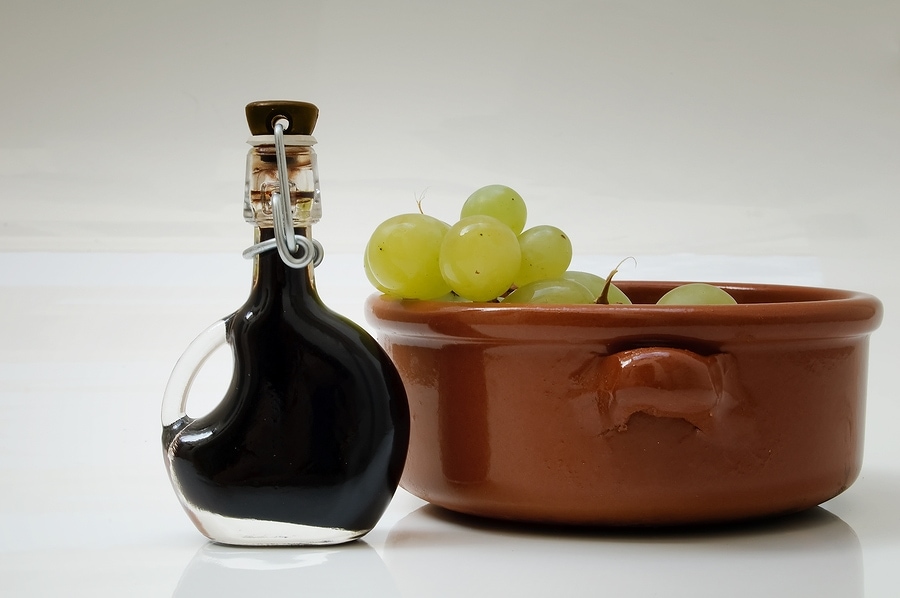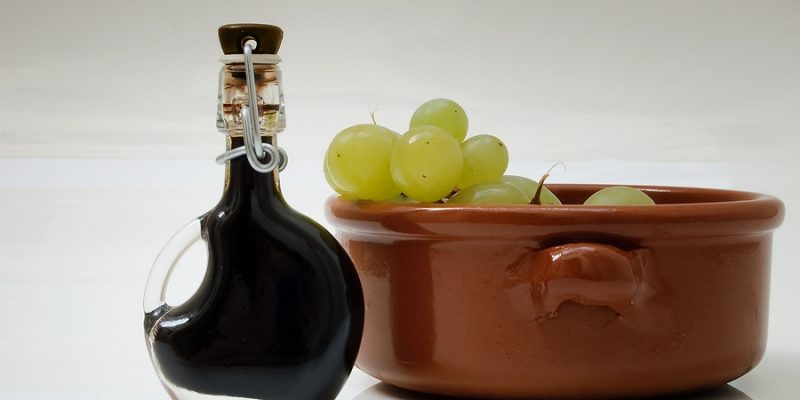Balsamic vinegar is a sweet, acidic condiment from Northern Italy that has become famous around the world because of its versatility and the unique flavor profile it adds to any dish. There are various styles and types of balsamic vinegar, but the genuine, balsamic vinegar comes in a small bottle, proudly displays its age and has a higher price tag, so you will use just a few drops at a time. However, if you ask chefs or home cooks who use this vinegar they will tell you that it’s worth every penny.

Keep reading to learn more about this delicious slow cooked vinegar and how it is made in Italy following the traditional methods.

You have probably spied all kinds of fancy bottles in the vinegar section of the supermarket touting themselves as “balsamic vinegar.” They are from various countries around the world and made with many different methods and grapes. But the truth is, most of the bottles you see on the supermarket shelves are not true balsamic vinegar from Italy but are cheap imitations instead.
What is balsamic vinegar, really? At a glance you can say that it is a thick, dark, concentrated vinegar that is made with grape must and undergoes fermentation. However, not all balsamic vinegars are created equal. In Italy, they are grouped into three main categories or grades: Traditional Balsamic Vinegar, Commercial-Grade Balsamic Vinegar and Condiment-Grade Balsamic Vinegar.
The practice of cooking and fermenting grape juice can be traced back to ancient Romans. The vinegar they produced was then used both as a medicine and in the kitchen to add sweetness and flavor. Records show that the area around Modena and Reggio Emilia was already producing special vinegar in 1046, when Henry III, Emperor of the Holy Roman Empire, was offered some of this delicious vinegar by the Marquis of Tuscany while passing through the area.
In 1747, the word “balsamic” appears for the first time and by the 19th century, balsamic vinegar gained international prestige and the first consortium to protect the product was founded.
The Spilamberto Traditional Balsamic Vinegar Museum opened in 2002 to celebrate this locally produced so-called “black gold.” The museum houses perhaps the oldest bottle of balsamic vinegar, at a whopping 280 year old, that was tasted and rated by experts who reported that it had the same acidity but was less sweet.

How can you know if you are buying the “real deal” traditional balsamic vinegar? These vinegars must come from just two areas in Italy – Modena and Reggio Emilia, the only ingredient is grape must and the vinegar is aged for a minimum of 12 years, which is clearly stated on the European Union approved label. These bottles proudly display a label stating they have a Denominazione di Origine Protetta or DOP in Italian translated as Protected Designation of Origin and abbreviated as PDO in English.
The traditional balsamic label applied will depend on the place where it was produced and how long it was aged. See the following list for the labels to look for to ensure it is not imitation balsamic vinegar but instead good balsamic vinegar: aceto balsamico di modena or aceto balsamico di Reggio Emilia.
Aceto Balsamico Tradizionale di Modena DOP is an original balsamic vinegar produced in Modena, Italy. Its quality and taste is checked and judged by the Consorzio Tutela Aceto Balsamico Tradizionale Di Modena. It is labeled Affinato when aged for a minimum of 12 years. It is labeled as Extravecchio when aged for a minimum of 25 years.
Aceto Balsamico Tradizionale di Reggio Emilia DOP is a traditional balsamic vinegar produced in Reggio Emilia, Italy. Its quality and taste is checked and judged by the Consorzio Tutela Aceto Balsamico Tradizionale Di Reggio Emilia. It is labeled Bollino Aragosta “Red Cap” when aged for a minimum of 12 years. It is labeled as Bollino Argento “Silver Cap” when aged for 18 years. And it is named Bollino Oro “Gold Cap” when aged for a minimum of 25 years.

Much like traditional balsamic vinegar, commercial grade balsamic vinegars that are produced in Modena are still considered authentic. However, this grade is often mass produced, may or may not be aged, and is made with more than just grape must. Aside from grape must, it typically also has wine vinegar and may or may not have natural caramel and other ingredients.
Instead of the DOP label, this type of balsamic vinegar has the IGP (Indicazione Geografica Protetta) label or in English PGI (Protected Geographical Indication). This indication is a less stringent production process than DOP and is regulated by the Consorzio Tutela Aceto Balsamico di Modena. However, it is nonetheless a significant one in protecting the authenticity of products made in Modena that must pass certain criteria for origin, quality, and recipe. Lastly, there are two types of Balsamic Vinegar of Modena PGI, depending on how long it was aged before bottling.
Balsamic vinegars that are made with the same ingredients, follow the same processes, but are made from other Italian regions or countries may request this designation, however, they cannot include the name “Modena” on the label.

Known as condimento balsamico in Italian, this grade is applicable to several types of products that have a higher quality than commercial grades. In particular, it is given to the following:
For these products, labels must clearly indicate that the authentic balsamic vinegar is only an ingredient and the use of the labels bearing the IGP or DOP in the ingredient must be approved by the appointed consortium.
Vinegars that belong in this grade may have the following labels:
Since many balsamic vinegars under this type are not regulated, they may vary greatly in quality, depending on various factors. However, you may still find a few worthy bottles without having to pay the hefty price tags of traditional balsamic vinegar of Modena.
Traditional balsamic vinegar is among the most highly valued culinary products from Italy. And rightly so, since it’s quite a versatile condiment that gives its unique intense flavor to any dish, whether sweet or savory.
Aceto Balsamico, as it is called in Italian, can enhance the complex flavors of all kinds of dishes, ranging from grilled meats, fowl, and seafood to something as unexpected as fresh fruits and creamy desserts. In fact, its rich flavor is the perfect finishing sauce drizzled on a bowl of fresh strawberries or a helping of yummy vanilla ice cream. It is also great in salad dressings.
The traditional balsamic vinegar of Modena has only one ingredient: grape must. However, the other types of balsamic vinegar can have the addition of wine vinegar, natural caramel and aged balsamic vinegar.
Other products that have none of the labels we have talked about so far might also include thickening agents such as guar gum when making balsamic products.

Simply, balsamic vinegar of Modena is made with grape must, and only grape must (which is technically just fresh crushed grape juice that contains the skins, seeds, and stems of the fruit which is then completely drained and filtered).
Traditionally, the grape varieties used to make true balsamic vinegar are Lambrusco varieties or Trebbiano grapes. This process is called the Solera Process and it includes the following steps:
If you are looking to purchase an exceptional bottle of traditional balsamic vinegar, you should look for the DOP (PDO) label. This will ensure that the grapes used are correct, that it was made in the right area of Italy and that the process for making the vinegar was followed.
You should look for a dark color, a rich brown almost black, and the more it has been aged, the thicker it should be. Especially vinegars that are 25 years old or older will have a thick, syrupy consistency. According to the Modena consortium website, the product should have a “bitter-sweet and balanced flavor” and a “slightly acetic and delicate aroma” that is “persistent, with woody overtones.”
You might be wondering if balsamic vinegar is the same as cider vinegar or red wine vinegar, but they are not the same thing. Both cider and red wine vinegar are made by fermenting cider and red wine respectively until they turn to acetic acid. They are watery, almost clear and have a much more acidic and sharp just vinegar taste with none of the sweetness or syrupy nature of aceto balsamico di Modena.
White balsamic starts with the same ingredient as the regular kind but then is pressure-cooked to prevent it from browning and does not go through the same aging process as the “black gold” version of aceto balsamico di Modena. The result is a clear, golden vinegar that is a less-intense version of the original. Besides it being more mild, chefs like the white version because it doesn’t turn their dishes brown.
Balsamic Pearls are small, soft spheres of the finest balsamic vinegar Modena PGI, which contain a concentration of rich scents and aromas. This is an innovative way to serve a classic Italian product and appeal to haute cuisine cooking at the same time. They can be used to enrich various dishes and look a little like caviar. However, vinegar is not the only ingredient, they also include thickeners and gelling agents. If you prefer, you can also make them at home.
Balsamic glaze or syrup is a reduction or thickened version of the original aceto balsamico di Modena and is delicious drizzled on salad or fruit but does not have the complexity of the aged version and comes at a much lower price point. It makes a great aged balsamic vinegar substitute when you don’t have the time or money to get the real deal.
As with wine vinegar, balsamic vinegar should be kept away from light and heat but stored at room temperature. To store it properly, it must be in a sealed container and stored in a dry place without light.
You might be wondering if balsamic vinegar can go bad and how long it can be kept for, especially given the high price of some bottles. According to one brand of commercial grade products the typical shelf life of the commercial product is between 3 and 5 years, just like wine vinegar. However, if you store it properly, good balsamic vinegar can last for much, much longer. And if it is real traditional balsamic vinegar, the expiration date will be in 10 years and just like fine wine it will keep getting better with age!